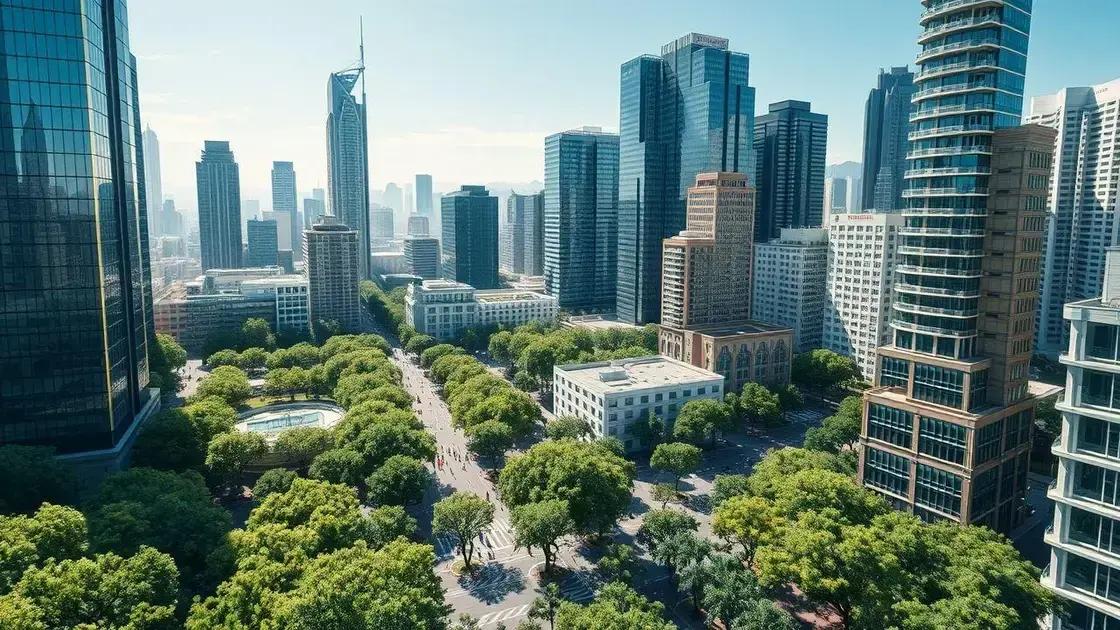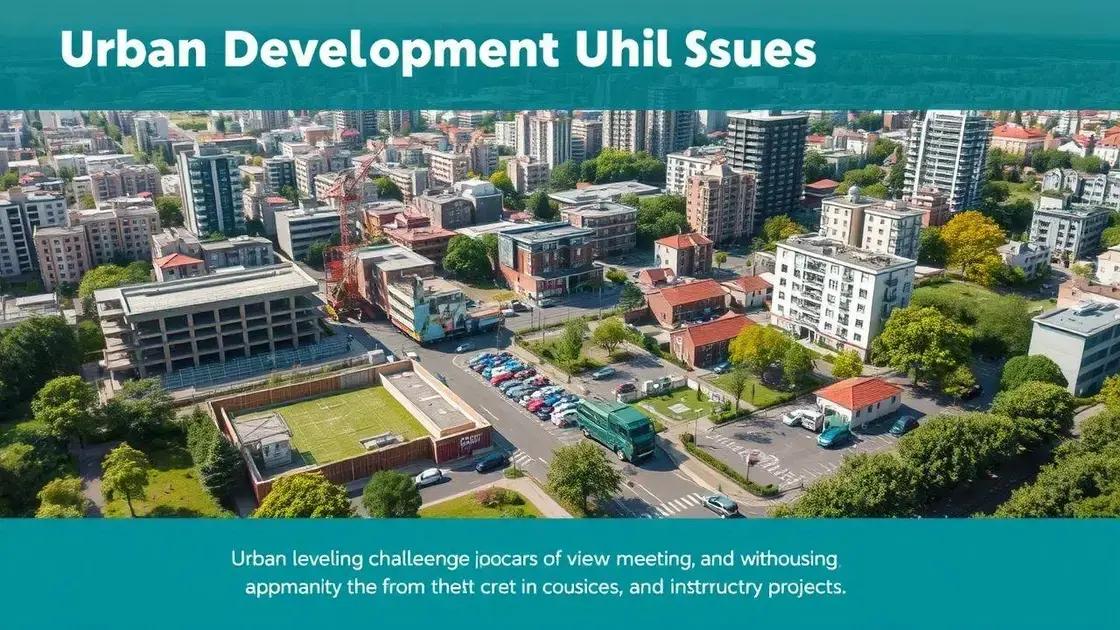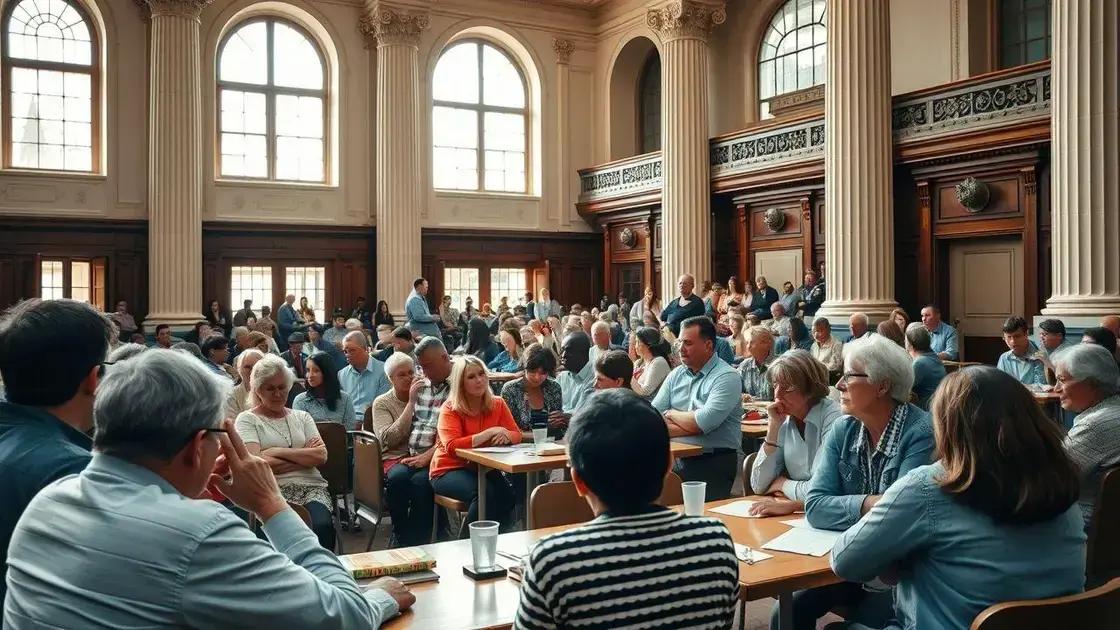Urban development plans that reshape our cities

Urban development plans focus on integrating technology, sustainability, and community engagement to create functional and vibrant urban spaces that accommodate growth while enhancing the quality of life for residents.
Urban development plans play a crucial role in shaping the spaces we inhabit. They influence everything from transportation to housing affordability. Ever wondered how these plans affect your neighborhood?
Understanding urban development plans
Understanding urban development plans is crucial for anyone interested in how cities function and evolve. These plans guide growth and development, ensuring that urban areas are well-organized and sustainable.
Urban development plans typically include various elements that ensure communities thrive. One important aspect is land use. A well-thought-out land use plan can help balance residential, commercial, and industrial zones, making neighborhoods more functional.
Key Components
Effective urban development plans often contain:
- Transportation systems: Smooth traffic flow is essential for any urban area. This includes roads, public transit, and pedestrian pathways.
- Green spaces: Parks and recreational areas not only beautify but also provide residents with places to relax and enjoy nature.
- Infrastructure: Utilities, such as water and electricity, need to be planned to support population growth.
- Community facilities: Amenities like schools, healthcare centers, and libraries must be considered to meet residents’ needs.
Another key aspect of urban development plans is community engagement. Involving the public ensures that the plans reflect the needs and desires of residents. This input can lead to more successful and accepted development projects.
The Role of Regulations
Regulations also play a significant role in urban development. Zoning laws, building codes, and environmental assessments guide the development process. These rules are essential for maintaining order and ensuring that growth does not negatively impact the environment or community.
As cities continue to grow, understanding the intricacies of urban development plans becomes increasingly vital. By grasping how these plans work, residents can better navigate their rapidly changing environments. Having a say in this process helps create more livable, sustainable cities for everyone.
Key components of successful urban plans
Key components of successful urban plans are essential for building functional and attractive cities. Understanding these elements can help communities thrive while meeting the needs of their residents.
One of the most important components is a well-designed land use plan. This plan organizes how different types of areas are utilized, such as residential, commercial, and industrial spaces. A balanced approach ensures that neighborhoods have what they need while avoiding overcrowding and inefficiency.
Essential Elements of Urban Plans
Successful urban plans generally include:
- Transportation and infrastructure: Efficient public transport options and well-maintained roads are vital for connecting different parts of the city.
- Green spaces: Parks, gardens, and open areas enhance the quality of life, promoting recreational activities and improving air quality.
- Housing variety: Offering diverse housing options addresses different income levels and family sizes, making neighborhoods more inclusive.
- Community facilities: Schools, healthcare, and recreational centers are crucial for daily life and should be strategically placed within communities.
Another aspect to consider is community feedback. Engaging residents in the planning process leads to better results. When the public has a say in the process, the plans tend to reflect the needs and wants of those who live there.
The Role of Policies in Urban Planning
Policies, such as zoning regulations and environmental assessments, guide the development process. These rules help manage how land is used, protecting the environment and ensuring accessible amenities for residents.
As cities evolve, focusing on these key components allows planners to create vibrant urban environments that meet contemporary challenges and residents’ needs. By prioritizing thoughtful planning, communities can flourish and adapt over time.
Challenges in urban development

Challenges in urban development can significantly impact the growth and sustainability of a city. These obstacles often arise from various factors that planners must navigate to create effective solutions.
One major challenge is balancing economic expansion with environmental sustainability. Urban development can lead to increased pollution and loss of green spaces. Therefore, finding a way to develop land while preserving natural habitats is crucial.
Common Urban Development Challenges
Here are some common issues faced during urban development:
- Infrastructure demands: As cities grow, the need for upgraded facilities like roads, bridges, and public transportation also increases.
- Funding constraints: Limited financial resources can hinder the implementation of essential projects.
- Community opposition: Residents may resist changes in their neighborhoods, leading to conflicts between planners and the public.
- Regulatory hurdles: Navigating zoning laws and building codes can slow down or complicate development projects.
Another significant challenge is providing affordable housing. With population growth, housing prices often rise, making it difficult for low- and middle-income families to find suitable options. Developers must find innovative ways to create affordable housing that meets demand without compromising quality.
Adapting to Change
Urban planners must also consider the impact of climate change on urban development. This includes planning for rising sea levels, extreme weather events, and other environmental changes. Making cities resilient to these threats is essential for long-term sustainability.
In addition, engaging with the community is vital to successfully navigating these challenges. Gathering input and building trust with residents can lead to more accepted and effective urban development strategies. As cities face these challenges, it’s crucial for planners to be adaptable and innovative, ensuring that urban areas remain livable and vibrant for future generations.
Innovative examples of urban planning
Innovative examples of urban planning showcase how cities are adapting to modern challenges. These examples often highlight smart designs that enhance community living while addressing sustainability.
One remarkable approach is the concept of mixed-use developments. These designs integrate residential, commercial, and recreational spaces. By combining these elements, cities can create vibrant neighborhoods where people live, work, and play without needing to travel far.
Noteworthy Innovations
Here are some innovative urban planning examples:
- Green roofs: Many urban areas are now utilizing green roofs on buildings. These roofs not only provide insulation but also reduce stormwater runoff and enhance biodiversity.
- Smart cities: Cities like Barcelona and Singapore are examples of using technology to improve urban living. Smart sensors and connected infrastructure help manage traffic, reduce waste, and ensure efficient energy use.
- Transit-oriented development: This planning strategy focuses on creating high-density buildings near public transit stations. It promotes the use of public transportation, reducing car dependency.
- Pedestrian-first initiatives: Cities such as Copenhagen have transformed their streets to prioritize pedestrians and cyclists. These changes promote healthier lifestyles and improve air quality.
Another interesting example is the use of urban agriculture. Cities are encouraging local food production through community gardens and rooftop farms. This not only provides fresh produce but also fosters community engagement and education.
Sustainable Infrastructure
Furthermore, sustainable infrastructure plays an essential role in innovative urban planning. Cities are increasingly incorporating renewable energy sources, like solar panels and wind turbines, into their designs. This shift helps reduce carbon footprints and encourages energy independence.
As urban areas continue to grow, learning from these innovative examples equips planners with the tools to create sustainable, livable cities. By implementing unique strategies, cities can enhance the quality of life for their residents while addressing environmental concerns.
The future of urban development
The future of urban development is shaped by innovation and a focus on sustainability. Planners and architects are now tasked with creating spaces that accommodate growth while being environmentally responsible.
One trend is the integration of technology into urban designs. Smart cities will use sensors and data to improve infrastructure, manage energy consumption, and enhance overall quality of life for residents. For instance, smart traffic signals can reduce congestion by adjusting in real-time to vehicle flow.
Key Trends in Urban Development
Some key trends shaping the future of urban development include:
- Sustainable building practices: The use of recycled materials and energy-efficient designs is becoming standard in new constructions. This helps minimize the environmental impact of buildings.
- Increased focus on public transportation: Many cities are investing in robust transit systems. Expanding public transport options reduces traffic and makes commuting easier for everyone.
- Green spaces: Cities are recognizing the importance of parks and nature. Green spaces improve air quality and provide a refuge for residents to relax and enjoy outdoor activities.
- Mixed-use developments: These projects combine residential, commercial, and recreational areas. They create vibrant neighborhoods where people can live, work, and play—all in one place.
Another important aspect of future urban development is resilience to climate change. Cities are designing buildings and infrastructure that can withstand extreme weather events. This proactive approach seeks to protect communities from potential disasters.
Community-Centered Planning
Engagement with residents is essential for successful urban planning. By involving communities in the decision-making process, planners can ensure that developments meet the needs of those who will be affected. Workshops, surveys, and public forums are great ways to gather input and ideas.
The future of urban development lies in balancing modernization with the preservation of community and environment. By focusing on innovative solutions, cities can improve living conditions and create spaces that are both functional and sustainable.
\n
FAQ – Frequently Asked Questions about Urban Development
What are the key components of successful urban planning?
Successful urban planning includes elements like efficient transportation systems, green spaces, mixed-use developments, and community facilities.
How can technology improve urban development?
Technology enhances urban development through smart infrastructure, data analysis for traffic management, and improved public services.
What challenges do cities face in urban development?
Cities face challenges such as funding constraints, community opposition to projects, regulatory hurdles, and the need for affordable housing.
Why is community engagement important in urban planning?
Community engagement ensures that urban development reflects the needs and desires of residents, leading to more accepted and effective solutions.






